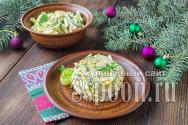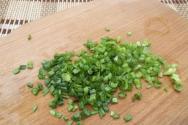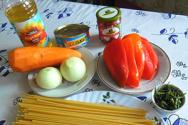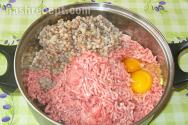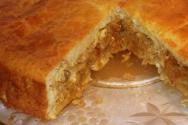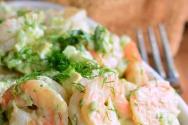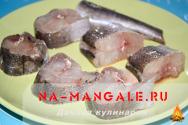Salting lard - some recommendations for salting lard. How many days to salt lard in brine: advice from culinary specialists Lard gave water when salting, what to do
Lard, despite the fact that it is 100% fat, is a very healthy product. It is completely absorbed by the body, and can be found in almost any meat department. Most often it is eaten salted, and anyone can cook it this way; it’s not difficult at all. If you want to pickle lard yourself, you should start by choosing the right lard. The product must be fresh; the best lard is obtained from the sternum. It should be smooth, without lumps or any compactions. Choose a piece 3-4 centimeters wide, and the meat layer will only improve the taste. In addition to this, you will also need, of course, salt and a glass jar or plastic bag.
Salt in a plastic bagThe layers of lard must be cut into smaller pieces (approximately 6x10cm). You need to take a lot of salt (under no circumstances take iodized salt - iodine can corrode everything) and thoroughly grind the lard with it. After this, the resulting pieces are placed in a plastic bag and sprinkled with a little more salt. The bag is tightly tied and left at room temperature. After 3 days, the lard will give juice, so the bag should be turned over and placed in the refrigerator for a few more days. If your lard has a meat layer, then the readiness of the product can be determined by the fact that it darkens. If there is no such layer, then after 3 days in the refrigerator the readiness of the lard can be checked simply by tasting it. If you are satisfied with the taste of the finished product, then remove the remaining salt with a napkin and store the lard in the freezer.
If you want to diversify the taste, then before salting you can make cuts and add half a clove of garlic. You can simply leave the garlic in the bag before sealing it. As a spice, dill seeds go well with salted lard - they give a very subtle aroma and good taste.
Method of pickling in a glass jar
Lard can also be prepared in brine; for this, use a large glass jar. It is cut into pieces and sprinkled with various seasonings. We have already talked about dill above, and in stores you can also find ready-made spice mixtures for lard. For a three-liter jar, take one and a half liters of boiling water, in which a glass of salt is dissolved. First you need to put the lard, and then fill it with the resulting solution. Make sure that it is completely hidden by this brine.
Close the jar with a lid and leave it in a slightly cool place (but not in the refrigerator) for a day, and then move it to the refrigerator for 4 days. After this, open the jar and drain the water. With this “wet method” of salting lard, it turns out soft and tender. You can salt in exactly the same way, using a cold brine solution - after you prepare it, wait until the mixture has cooled, and after that pour the lard into a jar.
So, choose the method that suits you best. If you want to store lard in the refrigerator and not in the freezer, then wrap it in plain paper. Bon appetit!
For salting, lard from the back or barrel of a pig carcass is better suited; the thickness should be 2.5 cm or more. For dry salting, you need to use enamel dishes. Before as salt the lard keep it in water for 10 hours. It will become tender and soft. The layers of meat should be thin. When salting lard, you need to use pressure, the lard will be salted better this way.
It is difficult to over-salt lard; it will absorb as much salt as it needs. But if the lard seems too salty, you need to dry it; after 2 days, the salt will come to the surface, it needs to be scraped off with a knife.
Garlic should be added to the prepared salted lard. Garlic-stuffed lard during the salting process should not be frozen. Since after defrosting, garlic does not smell very pleasant. The lard is first cleaned of excess salt and then rubbed with ground pepper. During salting, the lard must be turned over and poured with the released juice to ensure even salting of the lard.
Step-by-step photo - 3 recipes for salting lard
Necessary ingredients for dry salting lard:
Lard, coarse salt, black pepper, bay leaf, spice mixture, garlic (optional).
To pickle, cut the lard into pieces 10 cm wide, the thickness of the lard should be more than 2.5 cm, the length can be any, depending on the size of the enamel dish for pickling. Rub the lard on all sides with a mixture of salt and pepper.
Pour 0.5 cm thick salt onto the bottom of the container, lay pieces of lard so that there is a gap of 0.5 - 1 cm between the pieces and the side walls. After laying one layer of lard, fill all the gaps and lard with salt, and then lay a new layer. You can put a few bay leaves between the layers. After laying the last layer of lard, it is covered with salt.
We adjust the plate to the size of the pan, cover it and place a load (you can use a 3-liter jar of water). We leave it like that for a day. The next day, remove the weight, mix the lard, cover with a lid and put in the refrigerator for another 5 days. The lard needs to be stirred periodically to ensure even salting. After 5 days, remove the lard from the brine. Rub with a mixture of peppers and garlic. Place in bags and freezer.
Bon appetit!
I want to offer you a wonderful recipe for hot salting lard in onion skins. It is very simple and does not take much time to prepare. Lard cooked in onion skins Store in the refrigerator for three months.
So let's get started. We need pork salo, cut into pieces about the size of a fist, 7 glasses of water, 1 glass of table salt, coarsely ground, a couple of handfuls of onion peels, ground red or black pepper, 4 - 5 cloves of garlic. Pour water into the pan, add salt and onion skins. Place on the fire and bring to a boil. Boil the brine for 5 minutes and then add pieces of lard to it. Brine should completely cover salo, for uniform salting. Let's boil lard in brine 20 minutes. If the lard has layers of meat, then you need to boil it for about 40 minutes. Turn off the heat and leave the lard to cool brine for 24 hours at room temperature. After that, take it out of the brine and let it dry. Or wipe with a paper towel. Rub the lard with red or black pepper (ground). You can grate it with crushed garlic, but this is not for everyone. We put the pieces of lard into bags, let the lard sit in the refrigerator for a little longer, maybe another day, and then put it in the freezer. The lard turns out to be spicy and goes great with vodka. Bon appetit!!!
Salted lard Thus, it can be stored in a hermetically sealed jar for up to a year, while maintaining its taste. We will make salting of lard in “Ukrainian” brine. For this we need 2 kilograms of pork lard, bay leaf, 5 glasses of water, 1 glass of coarse salt, black peppercorns, three-liter jar.
Let's do brine, pour 5 glasses of water into the pan and pour in a glass of salt. Boil for 5 minutes. Then remove from heat and cool to room temperature. We cut the lard so that the pieces fit effortlessly into the neck of a three-liter jar. We lay the first layer loosely, add 3 - 4 bay leaves and a dozen black peppercorns on top. Then the next layer and so on until the jar is full. On top again, bay leaf and pepper. Fill in lard in brine and close the lid. If for long-term storage, it is better to roll it up and put it in the refrigerator or cellar. If you are not going to store it for a long time, then a regular nylon lid will do. Keep the lard in brine for 1 week at room temperature. After this, the lard can be eaten. This method is also calledwet salted lard .
To choose the right lard, it is better to go to the market or farm store. First of all, pay attention to the color: it should be white or pinkish, but always uniform. The skin of the lard should be thin, smooth, without bristles and preferably with a veterinarian's mark.
Smell the lard. The smell of fresh product is subtle, sweetish and milky. The presence of a specific aroma indicates that the lard came from a boar. No amount of spices can remove the smell, so it’s better to refuse the purchase.
Pierce the lard with a knife, fork or match. If it pierces easily or with little resistance, the product deserves your approval.
After purchasing the lard, rinse it with running water, dry it well with a towel and begin the cooking process.
What to salt lard with
With salt, garlic, bay leaf, cumin, dill seeds and even onion skins and sugar.
When salting, do not be afraid to overdo it with salt. The main advantage of lard is that it will absorb as much salt as it needs.
How to pickle lard
At home, lard can be salted in three main ways:
By the way, no matter what method you choose, you will need to store the finished lard in the freezer.

- 1 kg of lard;
- 200 g salt;
- 20 g ground black pepper;
- ½ head of garlic.
Preparation
Cut the lard into cubes 4–5 cm wide.

Make cross cuts in each block. The depth is slightly more than the middle of the piece.

Pour all the salt into a deep container. Put lard there and rub well with salt on all sides.

Sprinkle pepper on top. If desired, you can use a mixture of red and black.

And cut the garlic into slices 1-2 mm thick and place them in the slits on the pieces of lard.


Transfer the lard into a container and refrigerate for 3-4 days.


The lard is ready. It tastes best with black bread.
For further storage, scrape off or rinse off excess salt, wrap the lard in a cloth, place in a bag, and then in the freezer.
 mag.relax.ua
mag.relax.ua
- 2 kg of lard;
- 5 glasses of water;
- 200 g salt;
- 1 head of garlic;
- 4 bay leaves;
- peppercorns and other spices - to taste.
Preparation
Wash the lard, dry it and cut it into small pieces so that they fit easily into the neck of the jar. The optimal thickness of the piece is 5 cm.
Prepare the brine. Pour 5 glasses of water into a saucepan, add salt, put on fire and bring to a boil. Remove from heat and cool.
Finely chop the garlic and rub it over the pieces of lard. Wash and dry the bay leaves.
Place the lard in a jar. Do not try to stack the pieces tightly: the lard may go rotten. Layer layers of lard with bay leaves and black pepper.
After this, remove the lard from the jar, dry with paper towels and rub with spices. You can use ground red pepper, cumin, paprika. Then wrap the lard in paper or a bag and put it in the freezer. In a day the lard will be ready.
 toptuha.com
toptuha.com
- 1 liter of water;
- 2 handfuls of onion peels;
- 3 bay leaves;
- 200 g salt;
- 2 tablespoons sugar;
- 1 kg of lard with a layer;
- 4 peas of allspice;
- 3 cloves of garlic;
- paprika, mixture of peppers - to taste.
Preparation
Pour water into a saucepan, add washed onion peels, bay leaves, salt, sugar. Bring the resulting mixture to a boil, add lard to it and cover with a plate so that it drowns in the liquid.
Bring the mixture to a boil again and then cook for another 20 minutes over low heat. Then remove the pan from the heat, cool and place in a cold place for 12 hours.
Take out the lard, dry it and rub it with a mixture of chopped garlic, paprika and a mixture of peppers. Wrap the finished lard in film or a bag and put it in the freezer.
Before serving, keep the lard at room temperature for 5 minutes and cut into thin pieces. This lard goes best with black bread and mustard.
Many countries have their own national varieties of salted pork fat - lardo, bacon, pancetta and many others. It turns out that almost every nation has its own way of preparing it. Lard is salted pork fat, which is the national product of Ukraine and Russia. Rural residents still stock this product in very large quantities today.
Lard is one of those national dishes that each individual family has its own recipe for cooking. There are also recipes that are passed down from generation to generation for a long time. Despite the fact that the main ingredients of this dish are pork fat and salt, there are many other nuances - how many days to salt the lard in brine, what else to add, and so on. Let's look at some recipes.
How to cook salted lard
The most important thing in creating a delicious product is to get a very good and fresh cut of pork fat from a reliable source. Do not buy frozen convenience foods. Try to find a fresh farm product. For one of the classic recipes you will need:
- 1 kg pork fat.
- 2 cups sea salt.
- A few bay leaves and peppercorns.
- A handful of garlic cloves.
- 2 teaspoons red pepper flakes.
How to do it
In this case, salt the lard with cold brine. Place the fat on a cutting board and let it sit at room temperature for an hour. Pour a layer of salt about 1 cm thick into a glass jar. Place pieces of lard on it. Top with a layer of bay leaves, peppercorns, red pepper flakes and a thick layer of salt on top. Fill everything with clean cold water until the pieces are lightly covered. How many days to salt lard in brine in this way? The jar should sit in the refrigerator for at least four days. Once this time is up, try the product. If you want to achieve a saltier taste, you can keep it for a few more days.

Salting in own juice
This is another option for how to deliciously salt lard in brine. In this case, it is not filled with water, but the brine is formed from the juices secreted by the product. The product prepared according to this recipe can then be processed by smoking. You will need the following:
- 1.5-2 kg of pork fat.
- Half a glass of sugar.
- 1 tablespoon molasses.
- 2 tablespoons kosher salt.
- 1 teaspoon pickling salt.
- 1 teaspoon fresh frozen black pepper.
How to salt lard this way
This is one of the most delicious recipes for lard in brine, as it is cooked in its own juice. Rinse the fat and wipe it thoroughly. Trim off any thin edges so that the piece is a uniform, long rectangle.

In a small bowl, combine sugar and molasses. Then add 2 tablespoons kosher salt, pickling salt and pepper. Apply this mixture evenly to a piece of lard, then place it in a glass container or jar and cover the top with a clean cloth. Place in the refrigerator and press regularly on the surface of the workpiece. You will see that a significant amount of liquid will be released. How many days to salt lard in brine according to this recipe? Since other ingredients are used here besides salt, the aging period must be at least seven days. When this time has passed, remove the lard from the jar and inspect it. It should be firm to the touch. If the flesh still seems spongy and soft, rub the piece with 2 more tablespoons of salt and place it back in the refrigerator for two days. When the lard is completely ready, drain all the liquid from it, rinse well and wipe the piece.
Salt only option
Of course, when salting lard, you can add any additional spices to ensure your favorite taste and aroma. But the classic is the use of salt alone. In this case, we salt the lard in a jar in hot brine. This product is easy to prepare. Subsequently, it can be used in many dishes. In this case, you need to accurately weigh the fat you want to prepare, since you will need to calculate the correct proportion of salt. You will need 30 grams of it for every kilogram of lard, as well as 500 ml of water.

Cut the fat so that you have even and uniformly sized pieces. You can remove or leave the skin (as you wish). Weigh the lard prepared for salting. Calculate the required amount of water, pour it into the pan and boil. Add salt and dissolve it completely, stirring thoroughly. Remove the pan from the heat and cool slightly. The brine should be hot, but not boiling water. Place pieces of pork fat in a clean jar and fill with the prepared hot liquid. Wait for the brine to cool and place the container in the refrigerator. How many days to salt lard in brine? Wait five days and then inspect and taste the finished product. When the lard is ready, rinse it and dry it.
Dried preparation for the winter
As a rule, salting products is carried out with the aim of preserving them for a long time. So that lard can be stored longer, it is advisable not only to salt it, but also to dry it. This is done very simply, and the result will pleasantly surprise you. How to salt lard in brine for the winter? For longer storage, it is advisable to add a little sodium nitrite to the product. This substance inhibits the development of mold spores and also gives the product a beautiful pinkish tint. In addition, the lard will become slightly sweet. This substance can be found commercially under the name “pink salt” (do not confuse it with Himalayan pink salt).

Some believe that this is the most delicious recipe for lard in brine. This may be due to the fact that this instruction does not have a clear recipe. The main thing is to maintain the proportions of water and salt. For every 500 ml of liquid, 75-100 grams should be added. You can measure the required amount with a tablespoon containing 25 grams of salt. The required amount of sodium nitrite must be calculated following the instructions on the package. The amount of sugar in the recipe is not indicated anywhere. You can add it or not (at your discretion). You can also put garlic, pepper, bay leaf, cumin and so on in the brine.
How to salt lard for the winter
Make a brine by mixing water, salt, pink salt (nitrite) and sugar (or other additives of choice). Heat the mixture over moderate heat in a saucepan, stir until completely dissolved. Turn off the heat. Cut the lard into pieces of equal size and thickness. Place it in a clean jar and fill it with brine. Remove any air bubbles (by vigorously stirring the liquid with the handle of a spoon) and seal tightly. Place it in the refrigerator and keep it there for five days. Stir the brine daily to evenly redistribute all the juices. Once five days have passed, remove the product and check for doneness. If the lard can be eaten, rinse it well under running water and wipe with paper towels. Place it on a wire rack lined with clean paper and leave it in a well-ventilated place for a while. A sticky layer should form on the surface, and the pulp should dry out somewhat. Such salted and dried lard can be stored for a very long time.

Another option for lard in its own juice
We offer another recipe for salting lard in brine. This step-by-step instruction looks very simple: you need to treat the fat with salt and sugar and then wait until a natural brine is formed using its own juice. You will need the following:
- Good quality fresh pork fat.
- Fine sugar - about 3 cups.
- Coarse sea salt - about 6 cups.
How to salt lard in your own juice
Mix sugar and salt. Generously rub the lard with this mixture on all sides. Place it in a jar and cover with the remaining salty-sweet mixture. Press everything well, cover with a cloth and place a heavy object on top as a press. Leave in the refrigerator for a day. The next day you will see that the lard has released juice. Strain it, sprinkle the fat again with a mixture of salt and sugar, and pour the strained brine on top. Place back in the refrigerator. Repeat this process for 10 days. The amount of brine will increase - do not pour it out, strain it and add it to the lard. Once the product is ready to eat, rinse and dry it. This lard can be eaten in this form, but if you wish, you can dry or smoke it.

Option with onion skins
This recipe for salting lard is also a classic one. The finished product acquires a specific aroma and shade. How to salt lard in onion brine? To do this you will need the following:
- 500 grams of pork fat.
- 1 liter of water.
- 1 glass of salt.
- Husks from about ten onions.
- Favorite spices to your taste (garlic, pepper, cumin, etc.).
Salt lard in brine with onion peels
Pour water into a saucepan, heat and add salt. Bring to a boil, stir until completely dissolved. Add the onion skins and simmer the brine for about five minutes. Add the lard directly to the boiling water (it should be completely covered with water). Reduce heat, adjust to a low simmer, and simmer the mixture for about ten minutes. Turn off the stove and leave everything covered for another 15 minutes. Then remove the lard, place it on a plate and press with a press to squeeze out excess brine. Let it cool completely.
At this time, prepare the spices. For example, you need to peel and cut the garlic into small pieces, crush the peppercorns and cumin with a knife, and crumble the bay leaf. Once the piece of lard has cooled, make small cuts in it across the entire surface. Rub it with a mixture of prepared seasonings so that some of it gets into the cuts. After this, wrap the piece in foil and place it in the freezer. In this form it can be stored for a long time. The longer it sits, the more flavorful it will become. You can eat it directly frozen, cutting it into thin slices with a sharp knife. Best served on black bread.
View full version: Why does liquid form when salting lard?
08-03-2009, 22:01
A question has arisen. I salted the lard (covered it with coarse salt and spices, wrapped it in foil, put it in the refrigerator) and when I took it out today, it was in a puddle of liquid. Why? I rinse it with water and immediately wipe it dry with a towel, but I didn’t wash the other piece and it’s still a puddle. I remember that my grandmother salted it, but no liquid came out. The lard was dry, the excess salt was shaken off and eaten.
08-03-2009, 22:19
I only have one thought, maybe the lard (meat) was pumped with water or defrosted. Then it’s clear where the water comes from.
08-03-2009, 22:36
How is it pumped up? We bought a quarter of a pig and then I butchered it. If another small piece is somehow soaked, then what can be done with part of the carcass? Thoughts on this matter are greatly needed. I’m just overcome with doubts whether we should continue to buy meat there (unless, of course, it’s the meat, and not just my hands growing out of the wrong place). Maybe they are somehow watered and fed? I remember gossip from Soviet times that cattle were fed salty food and then given plenty of water to increase their performance, etc.
Girls, what are you saying – the fat is pumped up!
ANY kind of lard, even the most homemade lard, releases water!
When salted, everything releases water.
When you fry meat, do you immediately salt the meat?
And if not before serving, do you add salt to the salad right away?
Salt draws water from tissues, fibers and other components of vegetation or living creatures.
My husband has been salting lard for a long time and with high quality, he cannot live without it.
So, he is terribly worried if the pieces are not all covered with brine.
Places the press, does not put it in the refrigerator, monitors the process)))
In general, a puddle of liquid is quite small in fact)))
And so - the process is normal
09-03-2009, 07:16
You know, maybe I’m wrong, I just came across a couple of times when you fry a piece of meat, but it turns out that you stew it in its own juices. True, I buy meat at the market. In any case, you need to listen to the specialists, maybe they will catch up)))
I wonder why no one is surprised that they come out of the steam room wet?
No, meat, chicken and fish are pumped up.
And there are champions among this - Brazil.
But we are only talking about freezing.
Pay attention in supermarkets to frozen meat, fish, chicken, we are talking about those that are in packaging.
There's only ice there.
Moreover, sometimes water reaches half the weight of the total mass.
And the squid is imported. They look like they're covered in ice.
This is called warming your hands on ice(s?).
But to pump up fresh meat or lard!
Nonsense!
09-03-2009, 10:35
So I really want to know the opinion of experts in salting lard - should there be a brine? Liquid, of course, must be released. But not in the same quantities. But the liquid content in meat and lard is different. And I also remember lard in the markets - after all, no one sells wet lard. It is always dry, the salt is wet. The salt takes away the released water and becomes damp. But so that almost all the salt dissolves...
What kind of lard do you salt?
plain lard or with layers?
I assure you - brine is a completely normal phenomenon
then the amount of liquid that secretes lard cannot be absorbed by salt
we add salt with a pack of coarse salt - the salt does not dissolve, but there is plenty of liquid
I’ll wait for a specialist (I wonder how he will identify himself?)
15 years of salting lard is certainly not experience))))
09-03-2009, 16:04
Lard without layers. Does anyone get “dry” lard?
Dazzling
09-03-2009, 18:19
Oh, I wanted some lard! :)
Can you tell me where I can buy delicious lard... Preferably with a layer and garlic!: support:
But I can’t find something
vBulletin® v3.6.12, Copyright ©2000-2018, Jelsoft Enterprises Ltd.
Source: 2006-2009.littleone.ru
